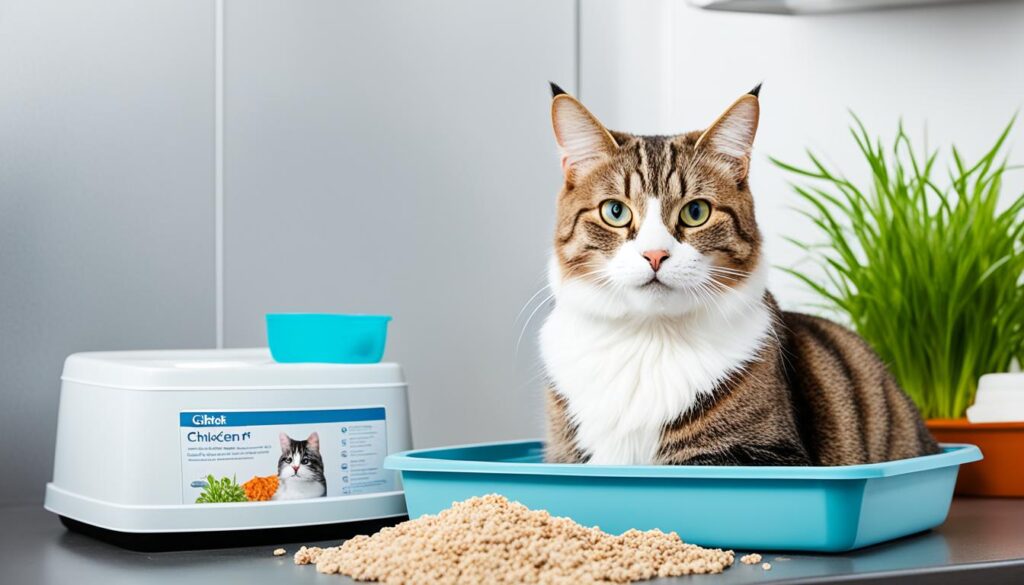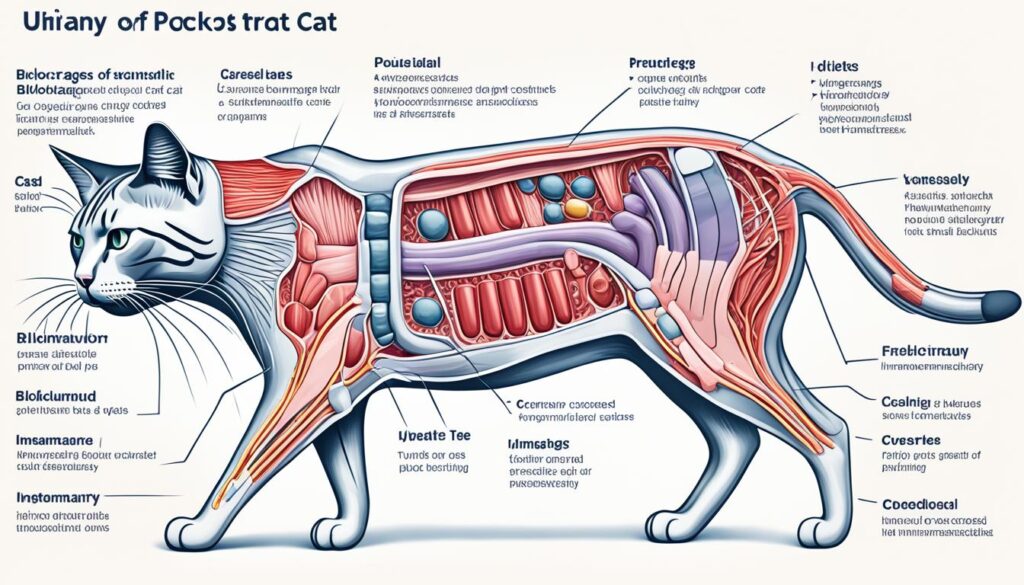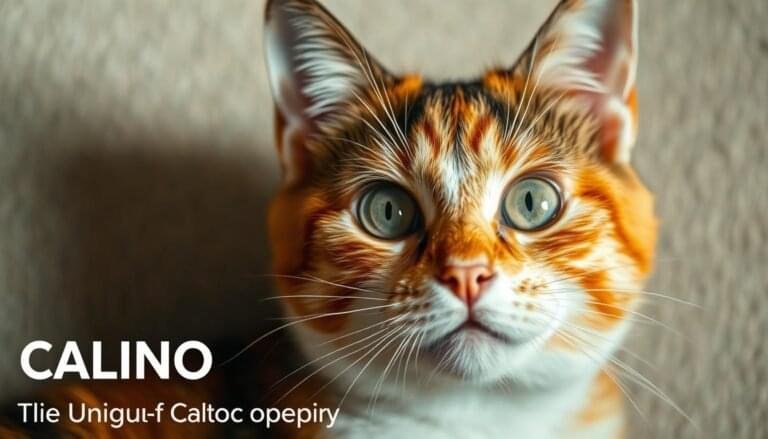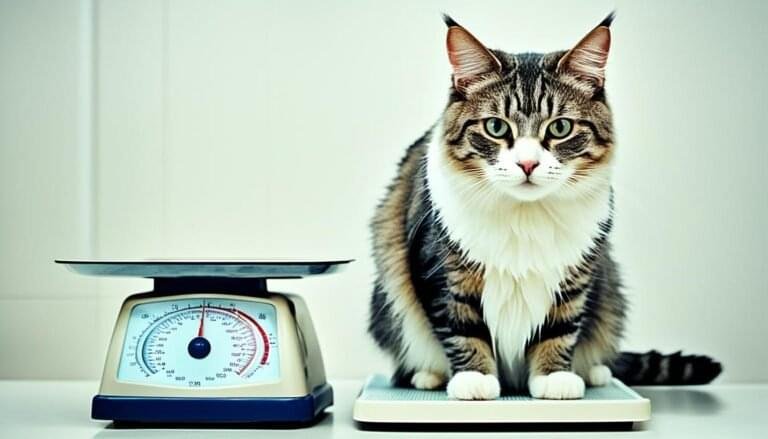Did you know that feline lower urinary tract disease (FLUTD) is a common issue in male cats? It affects a significant number of middle-aged, overweight cats, particularly those with little exercise and outdoor access. Stressors like changes in routine or living in a multi-cat household can also increase the risk. The impact of FLUTD on male cats’ urinary health is substantial and should not be ignored.
Key Takeaways:
- FLUTD is a common issue in male cats, especially those who are middle-aged, overweight, and have little exercise and outdoor access.
- Stressors like changes in routine or living in a multi-cat household can increase the risk of FLUTD.
- Major signs of FLUTD include straining in the litter box, urinating only small amounts, urinating outside the litter box, and blood in the urine.
- Diagnosing FLUTD can be challenging, but seeking veterinary care for a thorough evaluation and appropriate treatment is crucial.
- Treatment for FLUTD depends on the underlying cause, ranging from dietary changes to surgical interventions.
Common Causes of FLUTD
Understanding the common causes of Feline Lower Urinary Tract Disease (FLUTD) is crucial for addressing male cat peeing behavior changes, sudden urine marking, and other male cat urinary issues. FLUTD encompasses various conditions that can cause discomfort and distress in your feline companion. Let’s take a closer look at some of the common causes of FLUTD:
1. Urinary Stones
Urinary stones, also known as uroliths, are solid formations that can develop in the bladder or urethra of male cats, leading to blockages or irritation. The presence of urinary stones can cause your cat to exhibit inappropriate urination behavior and experience pain while urinating.
2. Urinary Tract Infections
Urinary tract infections (UTIs) can also contribute to FLUTD symptoms in male cats. Bacterial or fungal infections in the urinary tract can cause inflammation and discomfort, leading to changes in urinating behavior. UTIs require prompt treatment to alleviate the infection and address the underlying cause.
3. Urethral Obstruction
Urethral obstruction is a severe and life-threatening condition that warrants immediate veterinary attention. It occurs when the urethra becomes blocked, usually due to urinary stones or other obstructive material. Male cats are particularly prone to urethral obstructions due to their narrow urethral diameter, and it can result in a complete inability to urinate.
4. Feline Idiopathic Cystitis (FIC)
Feline Idiopathic Cystitis (FIC) is the most common cause of FLUTD in young cats. It is a complex condition without a clear underlying cause, but stress is believed to play a significant role. Male cats with FIC may exhibit changes in peeing behavior, including urinating outside the litter box or experiencing difficulty while urinating.
Each cause of FLUTD requires specific treatments ranging from dietary modifications to surgical interventions. It is essential to consult with your veterinarian for an accurate diagnosis and appropriate treatment plan tailored to your cat’s individual needs.
| Common Causes of FLUTD | Treatment Options |
|---|---|
| Urinary Stones | Dietary changes, stone-dissolving diets, or surgical removal |
| Urinary Tract Infections | Antibiotics, supportive care |
| Urethral Obstruction | Emergency veterinary care, catheter placement, surgery |
| Feline Idiopathic Cystitis (FIC) | Environmental modifications, stress reduction, medication |
Diagnosing FLUTD
Diagnosing feline lower urinary tract disease (FLUTD) can be a complex process as there is no one-size-fits-all test for this condition. It requires a thorough evaluation, including questions about the cat’s environment, a detailed physical examination, and urine tests. These tests help analyze various factors such as the pH level, concentration, presence of crystals or blood, and indicators of inflammation or infection in the urine.
One common test used in FLUTD diagnosis is the urinalysis. This test provides valuable information about the cat’s urinary health and can help identify any abnormalities. Other diagnostic tests such as X-rays, ultrasounds, and bloodwork may be recommended if the specific cause remains unknown.
Here are some of the key diagnostic steps for FLUTD:
- Gather information about the cat’s living environment and any recent changes that may have caused stress or anxiety.
- Perform a thorough physical examination to assess the cat’s overall health and check for any physical abnormalities in the urinary tract.
- Collect a urine sample for analysis, which may involve using a syringe or a non-absorbent litter.
- Conduct a urinalysis to examine the urine’s pH, concentration, and the presence of crystals or blood.
- Consider additional diagnostic tests such as X-rays, ultrasounds, or bloodwork to further evaluate the urinary system.
The combination of these diagnostic steps helps veterinarians identify the underlying cause of FLUTD accurately. Determining the cause is crucial for developing an appropriate treatment plan that addresses the specific needs of the affected cat.
Treatment Options for FLUTD
When it comes to treating Feline Lower Urinary Tract Disease (FLUTD), the approach will depend on the underlying cause of the condition. Understanding the cause is crucial in order to provide the most effective treatment for your male cat’s peeing behavior changes and urinary issues.
Urinary Stones
If urinary stones are causing FLUTD symptoms in your male cat, treatment options may include:
- A special stone-dissolving diet, formulated to break down the stones over time.
- Surgical removal of larger or more problematic stones if necessary.
Urinary Tract Infections
If a urinary tract infection (UTI) is the cause of your male cat’s sudden urine marking or inappropriate urination, treatment will typically involve:
- A course of antibiotics to eliminate the infection.
- Supportive therapies to alleviate symptoms and promote healing.
Urethral Obstruction
If your male cat experiences a complete urethral obstruction, it is a medical emergency that requires immediate intervention. Treatment options for urethral obstruction may include:
- Catheter placement to relieve the obstruction and restore urine flow.
- Surgery to address any underlying issues that may have contributed to the obstruction.
Feline Idiopathic Cystitis
Feline idiopathic cystitis (FIC) is a common cause of FLUTD in young cats, often triggered by stress. Treatment for FIC may involve a multimodal approach:
- Environmental changes to reduce stress and create a calm and secure space for your male cat.
- Diet modifications, such as specialized urinary health formulas, to support bladder health.
- Medication to manage pain and inflammation.
The goal of treatment for FLUTD is to manage symptoms, relieve pain, prevent recurrence, and improve your male cat’s overall urinary health. Consulting with a veterinarian is essential to determine the best course of treatment for your cat’s specific needs.
Preventing FLUTD

Preventing Feline Lower Urinary Tract Disease (FLUTD) is crucial for maintaining your male cat’s urinary health. By providing a supportive environment and implementing preventive measures, you can help reduce the risk of FLUTD and ensure your cat’s well-being.
Creating a Supportive Environment
Creating a safe and comfortable environment for your male cat can help alleviate stress and minimize the likelihood of urinary issues. Consider the following tips:
- Offer safe places for your cat to rest and sleep, providing comfort and security.
- Meet their sensory needs by providing scratching posts, toys, and interactive play sessions.
- Ensure clean and easily accessible litter boxes, with one box per cat plus an extra one.
- Offer fresh water at all times to encourage proper hydration.
- Encourage daily play and exercise to promote overall health and maintain a healthy weight.
Minimizing Stress
Stress can contribute to male cat peeing behavior changes and increase the risk of FLUTD. To reduce stress levels, consider the following suggestions:
- Create separate areas for sleeping, eating, and using the litter box if you have multiple cats, to avoid conflict and reduce competition.
- Keep a consistent routine to provide stability and minimize unexpected changes.
- Provide hiding spots and vertical spaces to give your cat opportunities to retreat and feel safe.
- Consider using pheromone diffusers or sprays to create a calming atmosphere.
Regular Veterinary Check-Ups
Regular veterinary check-ups and consultations are essential for maintaining your male cat’s urinary health. During these visits, your veterinarian can identify and address any potential urinary issues early on. They can also provide tailored advice on diet, lifestyle, and any necessary preventive measures.
By following these prevention strategies, you can significantly reduce the risk of FLUTD in your male cat and promote their overall urinary health.
| Preventive Measures for FLUTD | Description |
|---|---|
| Offer safe places to rest and sleep | A comfortable and secure environment reduces stress levels and improves overall well-being. |
| Meet sensory needs | Providing appropriate toys and interactive play sessions helps fulfill your cat’s natural instincts. |
| Provide clean and accessible litter boxes | Having enough litter boxes and keeping them clean reduces the risk of litter box avoidance. |
| Offer fresh water at all times | Proper hydration supports urinary health and helps prevent urine concentration issues. |
| Encourage daily play and exercise | Regular physical activity helps maintain a healthy weight and promotes overall well-being. |
| Create separate areas for multiple cats | Minimizing competition and providing individual resources reduces stress and potential conflicts. |
| Keep a consistent routine | Stability and predictability help reduce anxiety and stress in the cat’s daily life. |
| Provide hiding spots and vertical spaces | Offering places where your cat can feel safe and observe their surroundings reduces stress. |
| Consider pheromone diffusers or sprays | Calming pheromones can help create a soothing environment and alleviate stress. |
| Schedule regular veterinary check-ups | Regular check-ups enable early detection and intervention of any potential urinary issues. |
Urinary Blockage in Male Cats
Urinary blockage is a serious condition that commonly affects male cats, putting their health and well-being at risk. Neutered male cats are particularly prone to blockages due to their narrow urethras. Blockages can occur due to involuntary spasms, the presence of urinary stones, or the formation of urethral plugs.
Recognizing the signs of urinary blockage is crucial for early intervention and treatment. Common symptoms include:
- Straining to urinate
- Frequent attempts to urinate with little output
- Painful urination
- Bloody urine
- Urinating outside the litter box
If you notice any of these signs, it’s important to seek immediate veterinary care. In severe cases, a male cat might be unable to urinate at all, which is considered an emergency situation requiring urgent medical attention.
Veterinary treatment for urinary blockage typically involves:
- Hospitalization to stabilize the cat’s condition
- Fluid therapy to help flush the blockage and maintain hydration
- Removing the obstruction, which may require the use of a urinary catheter
Preventive measures can also play a crucial role in reducing the risk of urinary blockage. Ensuring your male cat stays properly hydrated by providing fresh water at all times is essential. Feeding a balanced diet that supports urinary health can help prevent the formation of urinary stones. Additionally, reducing stress in your cat’s environment and ensuring regular veterinary check-ups can help identify and address any potential issues before they become serious.
| Signs of Urinary Blockage | Treatment and Prevention |
|---|---|
| 1. Straining to urinate | 1. Hospitalization for stabilizing the cat’s condition |
| 2. Frequent attempts to urinate with little output | 2. Fluid therapy to flush the blockage and maintain hydration |
| 3. Painful urination | 3. Removing the obstruction using a urinary catheter |
| 4. Bloody urine | 4. Providing fresh water and feeding a balanced diet for prevention |
| 5. Urinating outside the litter box | 5. Reducing stress in the cat’s environment and regular veterinary check-ups |
Diagnosing and Treating Urinary Blockage

When a male cat experiences urinary blockage, immediate diagnosis and treatment are crucial to relieve the obstruction and prevent further complications. The condition can be life-threatening, causing immense pain and discomfort for the cat. It is essential to recognize the signs of urinary blockage, which include straining to urinate, frequent attempts with little output, painful urination, bloody urine, and inappropriate urination outside the litter box.
To diagnose urinary blockage in male cats, a comprehensive approach is required. It starts with a thorough physical examination, allowing the veterinarian to assess the cat’s overall health and identify any visible abnormalities. Blood and urine tests are commonly performed to analyze the cat’s kidney function, electrolyte levels, red and white blood cell counts, and other indicators of urinary tract health.
In some cases, imaging techniques such as X-rays or ultrasounds may be employed to visualize any obstructions or abnormalities within the urinary tract. These diagnostic tools help veterinarians determine the site and severity of the blockage, enabling them to devise an effective treatment plan.
Treatment Options
The treatment for urinary blockage depends on the severity of the obstruction. In less severe cases, a veterinarian may attempt to manually relieve the blockage by gently massaging the bladder or manually expressing the urine. However, this is only a temporary solution and may not address the underlying issue.
If the urinary blockage is more severe, immediate emergency care is required. A urinary catheter may be inserted into the blocked urethra to allow urine to drain from the bladder. This catheterization procedure is performed under anesthesia to minimize stress and discomfort for the cat. The catheter is typically left in place for a few days to ensure complete relief and to monitor the cat’s urinary function.
In some recurrent cases or when other treatment options have failed, surgery may be necessary to prevent future blockages. A perineal urethrostomy, a surgical procedure that creates a permanent opening in the urethra to bypass the narrowest part, may be recommended to facilitate urine flow.
Recovery and Aftercare
After relieving the urinary blockage, the cat will require close monitoring and supportive care during the recovery period. Hospitalization is often necessary to provide round-the-clock care, including administering medications, fluid therapy, and assisting with bladder emptying.
Dietary changes may be recommended to promote urinary tract health and minimize the risk of future blockages. Special diets formulated for urinary health can help dissolve urinary stones, reduce inflammation, and maintain a balanced pH level in the urine. It is important to follow your veterinarian’s recommendations regarding diet and feeding schedule.
Regular follow-up visits are essential to monitor the cat’s progress and check for any signs of recurrence or complications. Your veterinarian may perform additional tests to ensure that the urinary tract is functioning properly and no new obstructions have developed.
Incorporating preventive measures, such as providing ample access to fresh water, maintaining a stress-free environment, and feeding a balanced diet, can help reduce the risk of urinary blockages in male cats. Regular veterinary check-ups and consultations are pivotal in early detection and proactive management of urinary issues.
Preventing Urinary Blockage
Preventing urinary blockage in male cats involves several measures. It is essential to provide plenty of fresh water and encourage regular hydration to promote a healthy urinary tract. Additionally, feeding a balanced diet specifically formulated for urinary health can help prevent the formation of urinary stones and reduce the risk of blockages.
Reducing stress is also important in preventing urinary blockage. Cats are sensitive creatures, and stressful environments can contribute to urinary issues. Offering environmental enrichment, such as interactive toys and comfortable hiding places, can help alleviate stress and promote overall well-being.
Furthermore, providing an adequate number of clean litter boxes is crucial. Cats are clean animals and may avoid using a dirty litter box, which can lead to urinary problems. It is recommended to have one litter box per cat plus one extra, placed in separate areas of the house to ensure accessibility.
Regular veterinary check-ups and consultations play a vital role in preventing urinary blockage. Your veterinarian can assess your cat’s overall health, provide guidance on diet and lifestyle adjustments, and identify any potential issues early on. Early detection and intervention are key in maintaining your cat’s urinary health.
Preventive Measures for Urinary Blockage in Male Cats:
- Provide plenty of fresh water to promote hydration.
- Feed a balanced diet specifically formulated for urinary health.
- Reduce stress by offering environmental enrichment and a calm living environment.
- Ensure an adequate number of clean litter boxes are available.
- Schedule regular veterinary check-ups to monitor urinary health.
| Preventive Measures | Benefits |
|---|---|
| Providing fresh water | Promotes hydration and helps flush out the urinary tract. |
| Feeding a balanced diet | Prevents the formation of urinary stones and supports overall urinary tract health. |
| Reducing stress | Minimizes the risk of urinary issues caused by stress-induced bladder inflammation. |
| Offering environmental enrichment | Provides mental stimulation and relaxation, reducing stress levels. |
| Providing clean litter boxes | Promotes proper litter box usage and helps prevent the development of litter box aversion. |
| Scheduling regular veterinary check-ups | Allows for early detection and prevention of potential urinary problems. |
Urinary Tract Infections in Cats
Urinary tract infections (UTIs) are common in cats and can lead to various urinary issues, such as frequent urination, pain, and bloody urine. While female cats are more prone to UTIs, especially as they age, male cats can also experience these infections. UTIs in cats can be caused by various factors including bacteria, fungi, parasites, or viruses.
Diagnosing a UTI in cats involves a thorough physical examination, analysis of a urine sample for the presence of bacteria or other indicators of infection, and sometimes further testing such as culture and sensitivity testing to determine the most effective treatment. Speaking with a veterinarian is essential for proper diagnosis and treatment.
Common symptoms of urinary tract infections in cats include:
- Frequent attempts to urinate
- Painful urination
- Bloody urine
- Urinating outside the litter box
Treatment for UTIs typically includes a course of antibiotics prescribed by a veterinarian, along with supportive care to alleviate discomfort. It is crucial to complete the full course of medication as directed to ensure the infection is fully cleared. Implementing preventive measures can help maintain overall urinary tract health and reduce the likelihood of UTIs in cats. These measures include proper hygiene, providing fresh water, feeding a balanced diet, and minimizing stress.
Symptoms and Diagnosis of Urinary Tract Infections
Urinary tract infections (UTIs) can cause discomfort and urinary issues in cats. Common symptoms of a UTI may include:
- Straining to urinate
- Frequent attempts to urinate
- Painful urination
- Bloody urine
- Urinating outside the litter box
However, it’s important to note that some cats may not exhibit obvious signs until the infection becomes more severe. If you suspect your male cat may have a urinary tract infection, it is crucial to consult with a veterinarian for proper diagnosis and treatment.
Diagnosing a UTI typically involves:
- A physical examination: Your veterinarian will examine your cat’s abdomen, palpate the bladder, and check for any abnormalities.
- Analysis of a urine sample: Your veterinarian may collect a urine sample to test for the presence of bacteria or other indicators of infection. This can be done through a cystocentesis, where a sterile needle is used to extract urine directly from the bladder.
- Further testing: In some cases, additional tests such as urine culture and sensitivity may be necessary to determine the specific bacteria causing the infection and the most effective treatment. Imaging techniques like X-rays or ultrasounds may also be used to assess the health of the urinary tract.
By thoroughly evaluating your cat’s symptoms and conducting appropriate tests, your veterinarian can accurately diagnose a urinary tract infection and recommend the most suitable treatment plan.
| Common Symptoms of UTIs in Cats | Diagnosis Process |
|---|---|
|
|
Treating and Preventing Urinary Tract Infections
Treatment for urinary tract infections in cats generally involves a course of antibiotics prescribed by a veterinarian. It is important to complete the full course of medication as directed to ensure the infection is fully cleared. In addition to medication, supportive care may be necessary to ease your cat’s discomfort. Preventing urinary tract infections involves maintaining proper hygiene, providing fresh water, feeding a balanced diet, and minimizing stress. Regular veterinary check-ups can help monitor your cat’s urinary health and catch any potential issues early on.
When it comes to treating urinary tract infections in cats, the primary approach is to administer antibiotics prescribed by a veterinarian. These medications help eliminate the bacteria causing the infection and can effectively alleviate symptoms. It is crucial to follow the prescribed treatment plan and administer the full course of antibiotics to ensure the infection is fully eradicated.
In addition to antibiotics, supportive care may be necessary to alleviate your cat’s discomfort during the healing process. This may include providing pain relief medication, encouraging increased water intake to flush out the urinary system, and creating a comfortable and stress-free environment for your cat to recover.
To prevent urinary tract infections in your cat, it is essential to maintain proper hygiene. Regularly clean the litter box, ensuring it is free from debris and bacteria. Provide fresh and clean water at all times to encourage proper hydration, which helps to flush out the urinary system. Feeding a balanced diet specifically formulated for urinary health can also play a significant role in preventing infections. These diets are typically formulated with ingredients that promote a healthy urinary pH balance and reduce the likelihood of crystal formation.
Minimizing stress is another important aspect of preventing urinary tract infections in cats. Stress can weaken the immune system and make cats more susceptible to infections. Create a calm and secure environment for your cat, provide a predictable routine, and set up safe and comfortable spaces where they can relax.
Regular veterinary check-ups are crucial for monitoring your cat’s urinary health. During these check-ups, your veterinarian can assess your cat’s overall well-being, perform urine tests to detect any early signs of infection or other urinary issues, and provide personalized recommendations based on your cat’s specific needs.
By following these preventive measures and seeking prompt veterinary care when needed, you can help ensure your cat’s urinary health and reduce the risk of urinary tract infections.
Treating and Preventing Urinary Tract Infections – Key Points
- Treatment for urinary tract infections in cats typically involves a course of antibiotics prescribed by a veterinarian.
- Complete the full course of medication as directed to ensure the infection is fully cleared.
- Supportive care may be necessary to ease your cat’s discomfort during the recovery process.
- Prevent urinary tract infections by maintaining proper hygiene, providing fresh water, feeding a balanced diet, and minimizing stress.
- Regular veterinary check-ups can help monitor your cat’s urinary health and catch any potential issues early on.
| Treatment | Prevention |
|---|---|
| Administer prescribed antibiotics | Maintain proper hygiene |
| Provide supportive care | Offer fresh and clean water |
| Follow the treatment plan | Feed a balanced diet for urinary health |
| Minimize stress for the cat’s recovery | Regular veterinary check-ups |
Conclusion
Male cat peeing behavior changes can be a cause for concern and may indicate underlying urinary issues such as Feline Lower Urinary Tract Disease (FLUTD), urinary blockage, or urinary tract infections. Seeking prompt veterinary care is crucial to accurately diagnose and effectively treat these conditions.
Preventive measures play a significant role in maintaining the urinary health of male cats. Providing a supportive environment including a clean litter box, regular access to fresh water, and a balanced diet can help prevent future urinary issues. Minimizing stress factors and ensuring your cat’s overall well-being are also important.
It is essential to consult with your veterinarian for personalized advice and recommendations based on your cat’s individual needs. They can provide specific guidance on how to create an optimal environment and offer preventive strategies to minimize the risk of urinary issues. Regular veterinary check-ups will help monitor your cat’s urinary health and address any concerns early on.
By being proactive in understanding and addressing male cat urinary issues, you can ensure your furry friend maintains a healthy and comfortable life. Remember, early intervention, preventive measures, and veterinary guidance are critical in keeping your male cat’s urinary system functioning optimally.
FAQ
Why is my male cat peeing everywhere all of a sudden?
What are some common causes of FLUTD in male cats?
How is FLUTD diagnosed in male cats?
What are the treatment options for FLUTD in male cats?
How can I prevent FLUTD in my male cat?
What is urinary blockage in male cats?
How is urinary blockage diagnosed and treated in male cats?
How can I prevent urinary blockage in my male cat?
What are urinary tract infections in cats?
What are the symptoms and how are urinary tract infections diagnosed in cats?
How are urinary tract infections treated and prevented in cats?
References
| International Cat Association (TICA) | https://www.tica.org/ |
| The Cat Fanciers’ Association (CFA) | https://cfa.org/ |
| World Cat Federation (WCF) | https://www.wcf-online.de/ |
| Fédération Internationale Féline (FIFe) | https://www.fifeweb.org/ |







